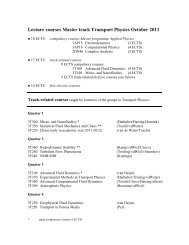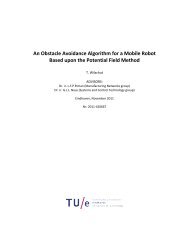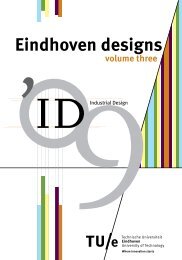Education guide 'Eindhoven designs' - Technische Universiteit ...
Education guide 'Eindhoven designs' - Technische Universiteit ...
Education guide 'Eindhoven designs' - Technische Universiteit ...
You also want an ePaper? Increase the reach of your titles
YUMPU automatically turns print PDFs into web optimized ePapers that Google loves.
108<br />
designer over the past semester, framed in<br />
their past development and envisioned future<br />
development. This may confirm, modify or<br />
reject what students themselves communicate<br />
through and conclude in their showcase. In this<br />
respect, the assessment is also feedback on<br />
the students’ ability to self-assess. In addition,<br />
the assessment gives feedback on the<br />
separate parts that make up the whole, such<br />
as students’ competency development profile.<br />
Last but not least, the assessment fulfils a feed<br />
forward function: it helps students fine-tune or<br />
adjust their long-term goals for their growth as<br />
a designer and set competency development<br />
goals in their Personal Development Plan for<br />
the next semester.<br />
Components of the<br />
assessment process<br />
In the assessment two parties are involved:<br />
the student and an independent assessor.<br />
Independent means that the assessor has<br />
not been involved as a coach in the student’s<br />
development process during the semester.<br />
The process of an assessment comprises<br />
three components. Each of these components<br />
provides the assessor with information from a<br />
different perspective:<br />
• The first component is the end-of-term exhibition.<br />
Here students show their project,<br />
framed in their overall development. They<br />
exhibit visuals about their project, including<br />
the process, as well as tangible deliverables.<br />
In addition, they ‘pitch’ their project to visiting<br />
students and staff members, including<br />
their assessor. The assessor has the opportunity<br />
to enter in a dialogue with the student<br />
and to ask explanatory as well as probing<br />
questions. The exhibition provides the assessor<br />
with extensive information about the<br />
student’s project. In addition, the assessor<br />
gets information on the student’s design<br />
process, his or her approach and attitude<br />
towards designing, and vision on designing.<br />
These exhibitions also create a platform for<br />
a dialogue between ‘peer-reviewers’. This<br />
may contribute to a frame of reference at the<br />
departmental level: what do we consider to<br />
be an adequate or typical second-year bachelor<br />
project, for example, or what illustrates<br />
a particular developmental stage best?<br />
The second component is the<br />
• showcasereview.<br />
The assessor goes through the student’s<br />
showcase, which gives information<br />
on the integrated whole of students’ development<br />
of their overall competence of designing,<br />
vision on designing and growth as a<br />
designer. The showcase also demonstrates<br />
students’ competency development and the<br />
quality of their deliverables as achieved in<br />
separate learning activities, and how these<br />
have contributed to the students’ overall<br />
development and growth. The central questions<br />
to be answered from this showcase<br />
review are: (1) what overall picture emerges<br />
in terms of the student’s overall competence<br />
of designing and vision on designing (observation).<br />
If the emerging picture is somehow<br />
diffuse, the assessor contacts the student’s<br />
competency coach for clarification; (2) which<br />
developmental stage does this represent<br />
(evaluation); (3) what is the student’s<br />
growth compared to the previous semester<br />
(observation) and to what extent does this<br />
represent an acceleration (evaluation); (4)<br />
to what extent has the student achieved (or,<br />
in case of excellence, has gone beyond) the<br />
expected developmental stage, given the<br />
block he/she has been doing (evaluation);<br />
and (5) can the student be promoted to the

















